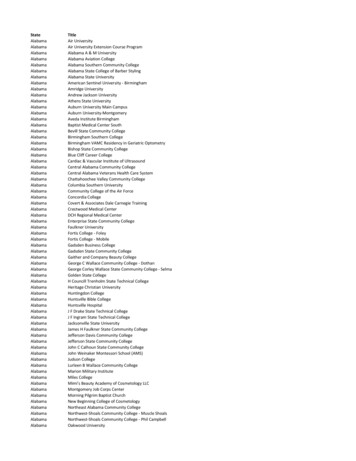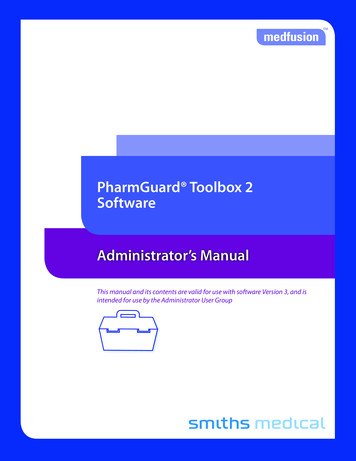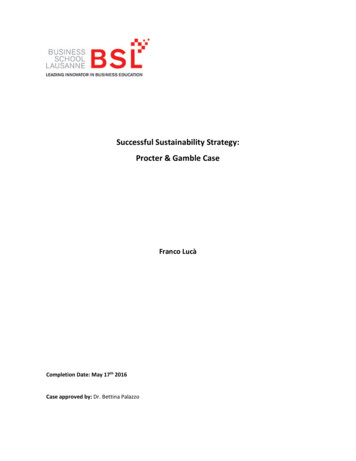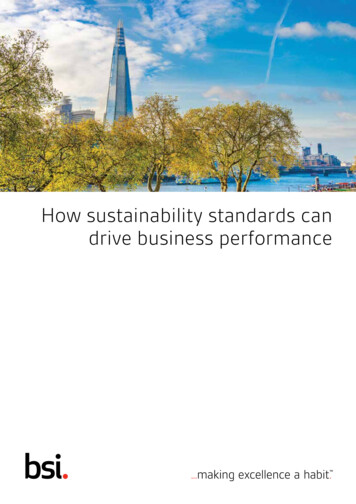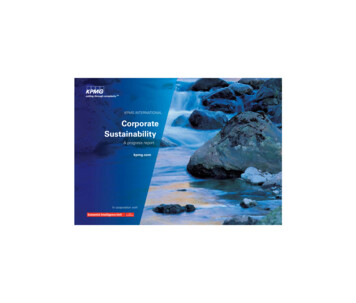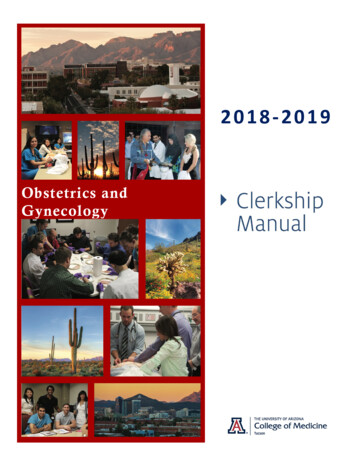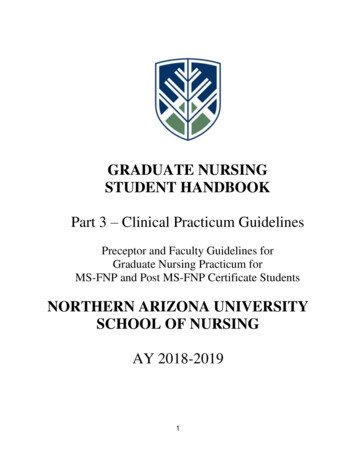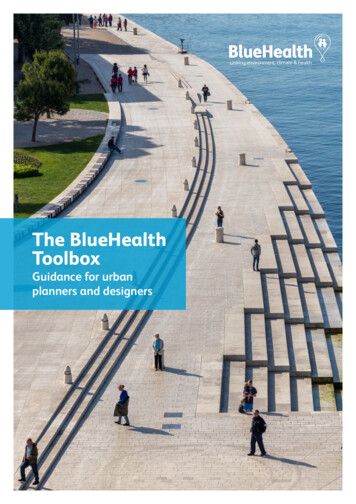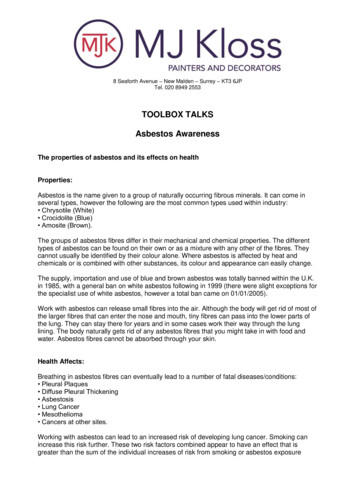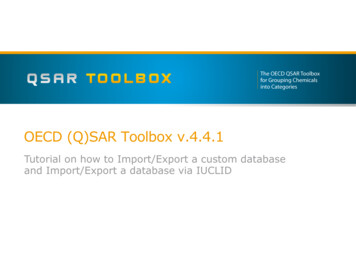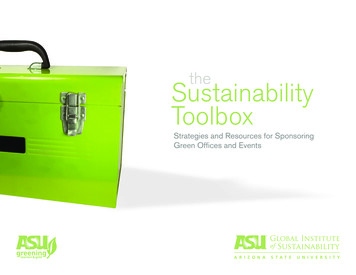
Transcription
theSustainabilityToolboxStrategies and Resources for SponsoringGreen Offices and Events
OverviewVisionGreening Your OfficesThe vision guiding the creation of the SustainabilityThe creators of the Sustainability Toolbox havecompiled factoids, strategies and resources for thefollowing key office categories to assist your officetoward a path of sustainability:Toolbox is to provide all ASU departments witheasy access to a comprehensive set of resourcesfor creating sustainability-conscious workplacesand for sponsoring zero-waste events. The Toolboxis intended to be an interactive, dynamic resourcethat enables departments to contribute as well as toutilize the “tools” in the Toolbox. Procuring Green Supplies Paper and Printing Electronics Furniture Reducing Paper Waste Waste Reduction and Recycling Reducing Energy ConsumptionCreatorsThe Sustainability Toolbox is created and managedby the Global Institute of Sustainability, UniversityThe Sustainability Toolboxis a collection of strategiesand resources forArizona State Universitydepartments that areinterested in sponsoring“green” offices and hostingsustainable events. Breakroom Environmentally Preferable Transportation Developing a Sustainability-OrientedWorkplace CultureSustainable Business Practices group. This groupwill continue to work closely with ASU Purchasing,Facilities Management, Surplus Property, andmany other departments to create an evenmore comprehensive and cohesive database ofsustainability practices.Hosting Sustainable EventsThe creators of the Sustainability Toolbox havecompiled factoids, strategies and resources for thefollowing key event categories to assist your officetoward a path of sustainability: Pre-Event Procuring Food Service Ware ItemsFor More InformationContact Betty Lombardo ofSustainable Business Practices. Food, Drink, and Catering Sustainable Menu Checklist Environmentally Preferable Transportationand Accommodation Reducing Energy Consumption Recycling and Composting Promotional Items Sustainable Event Communication Advertising/Printed Material/Signage Sustainable Event Evaluation
Table of ContentsOFFICESEVENTS5 Procuring Green Supplies17 Pre-Event7 Paper and Printing18 Procuring Food Service Ware Items8 Electronics19 Food, Drink, and Catering9 Furniture20 Sustainable Menu Checklist10 Reducing Paper Waste21 Environmentally Preferable Transportationand Accommodation11 Waste Reduction and Recycling12 Reducing Energy Consumption13 Breakroom14 Environmentally Preferable Transportation15 Developing a Sustainability-OrientedWorkplace Culture22 Reducing Energy Consumption23 Recycling and Composting24 Promotional Items24 Sustainable Event Communication25 Advertising/Printed Material/Signage25 Sustainable Event EvaluationClick this icon on any pageto return to the table of contents26 Resources
OfficesStrategies and Resources forSponsoring Green Offices
the Sustainability Toolbox Strategies and Resources for Sponsoring Green OfficesProcuring Green SuppliesStrategiesResourcesEvery office supply or appliance is associated with an environmental cost in terms ofthe resources and energy required to produce and operate the product. Purchasingonly the products and services that your office really needs, or sharing items suchas scanners, printers, and staplers, can reduce both ecological and economic costs.Sharing printers may also discourage excess printing.SimpleStepsChoosing products that have long warranties (i.e., products that are built to last) andthat can be easily upgraded or repaired will ultimately save money and reduce waste.Purchasing locally-made products substantially reduces the energy (and oil)consumption and pollution associated with transporting products from far away.“Buying local” also supports a robust regional economy. In general, purchasingsupplies from the nearest vendor, whether this vendor is one, ten, or 100 miles away,is environmentally- and often socially- preferable.Products that contain high percentages of post-consumer content are made ofmaterial that has previously been used and recycled. These products performat least as well as products that contain “virgin” resources. Check with vendorsfor office supplies that contain high levels of recycled material or post-consumercontent. Common products that contain recycled content include: binders, easels,envelopes, file folders, forms, paper and pads, pens and pencils, and self-stick notes.A colored background with a white recycling symbol indicates that aproduct contains recycled content.ASU’s Staples on-line catalog contains a section called “Staples EcoEasy” Going Green just got easier. It includes eco-friendly products.These product line items contain the following symbols: EcoEasyEnergy StarRecycledPurchasing products that are recyclable, and recycling them at the end of their usefullife, keeps reusable materials out of the landfill. Currently, ASU recycles paper,cardboard, aluminum, plastic, ink/toner cartridges, tennis shoes, books, and scrapmetal.5 2009 Global Institute of Sustainability at Arizona State University, Forest Stewardship Council, Non-Toxic, or.For more information about which products ASU recycles and how tohave these products picked up, access ASU Recycling or call 480-9657639.
the Sustainability Toolbox Strategies and Resources for Sponsoring Green OfficesProcuring Green Supplies me office furniture, printing inks, paints, and appliances (printers, fax machines)contain chemicals that may lead to skin and eye irritation, headaches, respiratoryproblems, and even carcinogenicity. To maintain healthy air quality, choose non-toxicproducts with low or no formaldehyde, trichloroethylene, or benzene content.ASU Purchasing contracts for products that minimize irritants, especiallyin furnishings, office machines, and office supplies. Contact GinaWebber, Associate Director of Purchasing and Business Services (gina.webber@asu.edu) for more information.Some vendors reuse packaging materials and/or employ a returnable credit systemfor packaging. Requesting that vendors take back unwanted packaging divertspackaging material from the landfill and sends a positive message to vendors thatsustainability is important to their clients.If you need assistance in this effort, contact Gina Webber, AssociateDirector of Purchasing and Business Services (gina.webber@asu.edu).Developing and/or updating a set of criteria for “green” office purchases such asbinders, clipboards, correction fluid, envelopes, highlighters/markers, labels, pens/pencils, presentation transparencies, file folders, self-stick notes, and toner cartridgescan make choosing these products much easier.ASU’s office supply contract is with Staples. Staples provides greenoffice products within the “Eco-Easy Products” section of their catalog.Contact Diana Gallese, Assistant Director, Stores Operations (dgallese@asu.edu) if you need assistance.Purchasing used office supplies decreases the amount of resources and energyneeded to produce new supplies. These supplies often function as well as newsupplies and may cost less.Arizona State University’s Surplus Property program allows ASUdepartments to donate unwanted furniture, computers, and other officesupplies. These supplies, which include desks, chairs, bookshelves,filing cabinets, computers, monitors, printers, etc are resold throughSurplus Property. Surplus Property is located at 2325 E. Rio SaladoPkwy (southeast corner of Rio Salado Pkwy and Price Rd). Retail salesoccur Monday-Friday, 2:00pm-4:00pm, and auctions occur the secondThursday of each month at 8:30am. To join the Surplus Propertiesauction notification service, e-mail surplus-q@asu.edu.According to Green Seal, Americans discard 1.6 million single-use pens annually.According to Green Seal, every ton of 100% recycled paper saves 4,100kW-hrs of energy, 7,000 gallons of water, 60 pounds of air emissions, and3 cubic yards of landfill space compared to a ton of virgin paper. 2009 Global Institute of Sustainability at Arizona State University
the Sustainability Toolbox Strategies and Resources for Sponsoring Green OfficesPaper and PrintingStrategiesResourcesPaper containing recycled content conserves natural resources and “closes the loop”between recycling and purchasing. The most environmentally friendly paper containsthe most post-consumer content. Look for products with greater than 30% postconsumer waste recycled content.Most professional printing services provide paper containing postconsumer content upon request.Chlorine bleaching releases dioxins, which are carcinogens that harm humansand the environment. Choosing chlorine-free (PCF: process chlorine free) papereliminates these harmful effects.If you need assistance in this effort, contact Gina Webber, AssociateDirector of Purchasing and Business Services (gina.webber@asu.edu).Find recycle paper products at Staples on the Staples website.SimpleStepsPurchase unbleached or chlorine-free, high post-consumer waste recycled paperproducts including binders and envelopes.Paper products manufactured using sustainable forestry practices minimize habitatdestruction and water pollution and support reforestation and recycling.Third-party certifiers such as the Forest Stewardship Council and theSustainable Forest Initiative endorse paper products and manufacturers whocontribute to sustainable forestry.Several of ASU’s contracted printers have attained FSC certification. Alist of these FSC printers is available here. Send an email to printserv@asu.edu to receive information about contracted FSC printers.The ASU Print & Imaging Lab, (480) 965-1636, which is located atthe Polytechnic Campus, has received certifications from the ForestStewardship Council (FSC) and the Sustainable Forestry Initiative (SFI).Staples also sells FSC-certified printing and copy paper.QuickFactsSoy-based inks are produced from soybeans instead of petroleum, which is theconventional printing ink. Many print shops have converted their supply to 100%soy-based inks. Check with your printing vendor to ensure that this sustainabilitypractice is being implemented.7According to Green Seal, every ton of virgin printing paper requires 24 trees. 2009 Global Institute of Sustainability at Arizona State UniversitySoy-based inks produce less than 1/5th of the volatile organic compoundthat conventional petroleum-based inks generate (source).
the Sustainability Toolbox Strategies and Resources for Sponsoring Green vesting in upgrades for existing devices instead of buying new appliances reducesthe amount of material waste sent to the landfill and reduces resources needed tocreate new appliances. Particularly for computers, regular upgrades can greatlyextend the life of the equipment without sacrificing speed and data storage capability.For software services, call the ASU Technology Team at (480) 965-9514.Lease electronics such as printers, fax machines, and copiers instead of buying theseproducts. Leasing is especially beneficial in offices that must upgrade equipmentregularly.Digital Document Services has a strategic alliance with Canon to provideprinting, copying, scanning and faxing equipment. See Canon SustainabilityReport 2008.Maintenance helps ensure that equipment is functional for as long as possible.Scheduling regular maintenance for all office equipment reduces the economic andenvironmental costs of purchasing office appliances.Choosing energy-efficient electronics reduces energy consumption, saves moneyon utilities bills, and reduces carbon emissions. ENERGY STAR is a good sourceof information about energy-efficient computers, copiers and fax machines, digitalduplicators, external power adaptors, notebook computers/tablet PCs, mailingmachines, monitors, printers/scanners/all-in-ones, and water coolers. EPEAT(Electronic Product Environmental Assessment Tool) certifies desktop computers,integrated systems, monitors, and notebook computers that meet environmentalstandards related to the reduction of environmentally sensitive materials, the use ofrecycled and renewable materials, design for recycling and reuse, longevity, energyconservation, corporate performance, and packaging.Seek electronics that emit low amounts of toxic chemicals such as cadmium, lead,and mercury.8 2009 Global Institute of Sustainability at Arizona State UniversityENERGY STAR publishes criteria for and lists of energy efficient officeproducts. EPEAT’s website and database of products are available online.
the Sustainability Toolbox Strategies and Resources for Sponsoring Green OfficesFurnitureStrategiesPurchase wood furniture that has been manufactured using sustainable forestry practices. Inparticular, attempt to procure wood products that use timber from a local source.ResourcesContact Gina Webber, Associate Director of Purchasing and Business Services(gina.webber@asu.edu) for contracted FSC furniture vendors.The Forest Certification Resource Council provides a list of products that arecertified by the Forest Stewardship Council and the Sustainable Forestry Initiative.Other furniture resources: ASU Furnishing ServicesSome office furniture contains chemicals that may lead to skin and eye irritation, headaches,respiratory problems, and even carcinogenicity. To maintain healthy air quality, choosenon-toxic products with low or no formaldehyde, aldehydes, 4-phenylcyclohexene, CFCs, orHCFCs.Steelcase and HON, two of ASU’s approved furniture vendors, offer a list oftheir products that have received the Scientific Certification Systems’ IndoorAdvantage third-party certification for low emitting products and materials.Access the list of certified Steelcase office furniture online.Access the list of HON certified office furniture.SimpleStepsAlso, Greenguard Environmental Institute offers an Indoor Air QualityCertification for products that emit minimal amounts of VOCs, formaldehyde, and4-phenylcyclohexene. ASU approved furniture vendors that offer GreenguardIndoor Air Quality Certified products include: KI (budget tables) SitOnIt Seating United ChairGreen Seal publishes a list of suppliers of office furniture that minimizes waste, isnontoxic, and emits minimal air pollutants.In some cases, office furniture can be deconstructed and remanufactured at the end of its life.“Recycling” office products by returning parts to the manufacturer reduces the resource andenergy needs required to produce these products. These products are also environmentallyfriendly throughout their life cycle. In general, products that are easy to disassemble are easierto manufacture than products that are not designed to be disassembled.Steelcase, one of ASU’s contracted furniture vendors, offers over 20 officeproducts (including seating, workstations, keyboard platforms, and marker boards)that have achieved Cradle-to-Cradle Certification. Cradle to Cradle Certifiedproducts are designed and produced using environmentally healthy materials andprocesses, and are designed in ways that promote ease of reuse. Access theSteelcase Cradle to Cradle Certified product list online.Choosing products that contain recycled/recyclable materials such as steel, aluminum,recycled PVC, or post-consumer PET plastic “closes the loop” between recycling and buyingrecycled products. Some environmentally-healthy office furniture contains recycled materials.Details (a division of Steelcase) produces lights, height-adjustable tables, andkeyboard assemblies that are made of recycled materials.Seek electronics that emit low amounts of toxic chemicals such as cadmium, lead, andmercury.9 2009 Global Institute of Sustainability at Arizona State University
the Sustainability Toolbox Strategies and Resources for Sponsoring Green OfficesReducing Paper WasteStrategiesResourcesUsing electronic rather than printed documents whenever possible reduces paper use,energy (consumed during printing), and ink. E-mailing memos and making importantdocuments accessible online gives staff the option of printing these documents or saving themelectronically.Copiers provided by Digital Document Services can scan documents directly toe-mail.Most printers and copiers have a double-sided (duplex) option, which can be set as the defaultprinting option. To print a double-sided document, choose File, Print, Properties, and thenlook under the Printing Shortcuts or Finishing tab to either “Print Duplex” or “Print on BothSides.” Some printers will automatically print on both sides, while others provide instructionsto manually print on both sides.For PCs with Microsoft Office, instructions for printing on both sides of paper areavailable here.SimpleStepsMaintaining an organized set back-up disks or CD-Rom of important data reduces the volumeof paper used in document storage.Most Microsoft Office programs have a “Draft” or “Economode” print setting that uses lesstoner. Choose this setting in “Print Properties” (under the “Paper/Quality” tab) and considermaking this option the default setting on office PCs and copiers.Devote a collection box or tray for the entire office to reuse “scrap” paper that has only oneside of printing. These pages may be used for notes or other informal documents. Sensitivedocuments (personal information, legal documents, and confidential information) should beshredded and recycled rather than reused.Instead of devoting an entire page of paper to a fax cover sheet, include transmission detailsin the document itself. Alternatively, affix a stick-on label with transmission details to the firstpage of the document to be faxed.ModerateCommitmentPrint multiple pages or Power-Point slides per sheet of paper for presentations. These taskscan be completed in using the commands “File,” “Print,” and choosing “Handouts” under the“Print What” section.10Before printing documents, preview them using “Print Preview” and adjust margins and fontsize to eliminate pages with only one or two lines of printing. Many programs have a “shrink tofit” function in the “Page Setup” section that allows the user to specify the number of pagesthat he or she wishes to print. 2009 Global Institute of Sustainability at Arizona State UniversityGreenPrint Technologies produces software that helps identify “unwanted pages”and analyzes each page to minimize the amount of paper required to print adocument. This software also tracks the amount of paper and money saved byreducing paper waste.
the Sustainability Toolbox Strategies and Resources for Sponsoring Green OfficesWaste Reduction and RecyclingStrategiesResourcesSimpleStepsSharing one or two staplers, hole punches, and other office supplies instead of providing oneof each of these tools to each individual reduces supply costs as well as the resource andenergy consumption required to furnish each staff member with a full set of supplies.Devote a box or cabinet in the office to save used but operational binders, folders, etc.Encouraging staff to use these supplies for every-day tasks reduces the energy and resourceconsumption required to buy new binders and folders.Whenever possible, reuse cardboard boxes, tape dispensers, file indices, and envelopes (forexample, use envelopes that can be resealed that include multiple address spaces for oncampus mail).ExtremeGreenModerateCommitmentOffice recycling programs represent a powerful way that offices can reduce their waste.Under-the-desk recycling bins for paper are provided by ASU Recycling. Collecting glass,plastic, and aluminum in a clearly-marked box or bin in the break room can also lead to thediversion of these resources from the landfill. Currently, ASU recycles paper, cardboard,aluminum, plastic, ink/toner cartridges, tennis shoes, books, and scrap metal.11ASU Stores will pick-up Hewlett-Packard print cartridges from any ASUdepartment. For pick-up contact ASU Stores at 480-965-3772.Battery recycling is operated by Risk Management (Hazardous Waste). For batterypick-up, contact 480-965-0647.For more information about which products ASU recycles and how to have theseproducts picked up, see ASU Recycling or call 480-965-7639.Appointing a “Recycling Coordinator” or arranging a rotating schedule of staff memberto check for contamination (non-recyclables in the recycling bins) and to ensure that therecyclables are reaching their appropriate drop-off stations can help to ensure the successand longevity of an office recycling program.Rewritable compact discs (CDs) may be reused for data storage. Scratched or non-rewritableCDs may be sent to recycling companies for refinishing or recycling.A list of CD recyclers is available in Green Seal’s Choose Green Report: OfficeSupplies.Discarding food waste sends important organic nutrients to the landfill. Indoor compostingunits to store under a desk or in the break room are a viable alternative that diverts food wastefrom the landfill. These units convert kitchen wastes (food scraps, etc.) into organic fertilizer.Learn how to create an effective indoor composting program. 2009 Global Institute of Sustainability at Arizona State UniversityOdor-free units are available from many different vendors, including SustainableCommunity Development and The Bin Doctor.
the Sustainability Toolbox Strategies and Resources for Sponsoring Green OfficesReducing Energy tSimpleStepsStrategies12ResourcesShut down computers and turn off monitors at the end of the day. Turn off lights and otherequipment when they are not being used. If an office has windows and natural lighting, turn offthe lights when daylight is sufficient.In most cases, shutting down computers will not cause damage. Office ITconsultants will know whether a department or office’s computers can be turnedoff at the end of the work day.Maintain an office temperature to be no higher than 68 F, and cooled to no lower than 80 Fto reduce the amount of energy used for space conditioning. Room Temperature guidelines atASU’s Tempe campus mandate that offices and classrooms remain within the 68 F to 80 Fdegree range.If your office temperature needs to be changed to fall within the 68–80 degreerange, contact ASU’s Service Center. Fill out an online Service Request Form,Fax your request to the Service Center at 480.965.0120, Send an email toFACMAN, Mail a memorandum to the Service Center (Mail Code 5112), or call480-965-3633.Activating energy-saving features on applicable PCs, printers, photocopiers, etc. helps toconserve energy and save money. A good rule of thumb is to set your machine to enter lowpower (“sleep”) mode after 15 minutes of inactivity.The Department of Energy’s ENERGY STAR program offers a set of instructionsfor activating power management features (e.g., “sleep mode”) for a variety to ITsystems.Use the most energy efficient light bulbs available. Replace incandescent light bulbs withcompact florescent bulbs (CFLs); and replace T-12 florescent lamps with the 20% moreefficient T-8 florescent lamps. Also replace incandescent lights in Exit signs with CFLs or lightemitting diodes (LED).ASU Facilities and Planning Management uses the most efficient bulbs for eachlocation.ASU’s utilities company (APS) sells CFL bulbs.Identify areas of the office that are lit or air conditioned but are generally unused. If possible,keep the lights and HVAC system off in these areas.Invest in energy-efficient computers, printers, copiers, fax machines, and other equipment.ENERGY STAR publishes criteria for and lists of energy efficient office products.Access ENERGY STAR’s Office Equipment guidelines and database of productsonline at http://www.epeat.net/.Purchase “green power” through the local utilities company. Through its “Green Choice”program, APS allows its customers to purchase energy generated from renewable resourcessuch as wind and geothermal.APS (Arizona Public Service) is ASU’s utilities provider. APS Green Choiceoffers resources and tips for saving energy, finding retailers of discounted CFLbulbs, and buying electricity from renewable sources.According to the U.S. Environmental Protection Agency, commercial buildings account for18% of the nations greenhouse gas emissions. Lighting contributes substantially to thisstatistic.According to the U.S. Environmental Protection Agency, activating a computer’s“Sleep” mode will save over 1,000 tons of carbon dioxide annually as comparedto leaving the same computer idle. These savings equate to about 10% of theemissions that a car generates annually. 2009 Global Institute of Sustainability at Arizona State University
the Sustainability Toolbox Strategies and Resources for Sponsoring Green OfficesBreakroomStrategiesEncourage staff to bring their own reusable mugs, plates, and silverware so that the breakroom does not need to be supplied with single-use utensils and supplies. Also considerstocking the break room with reusable dishware and cutlery, along with dish-washing soap andsponges.ResourcesIn most cases, shutting down computers will not cause damage. Office ITconsultants will know whether a department or office’s computers can be turnedoff at the end of the work day.SimpleStepsSchedule regular maintenance of break room appliances such as refrigerators and watercoolers. Leaks and faulty appliances should be repaired as soon as possible.According to a book by Sustainable Industries’ titled Green Office Guide, chlorine bleachingreleases dioxins, which are carcinogens that harm humans and the environment. Choosingchlorine-free (PCF: process chlorine free) paper eliminates these harmful effects. Use nonchlorine-bleached paper towels, napkins and coffee filters.Non-chlorine bleached coffee filters can be found in most grocery stores.Use appliances that do not require electrical input to operate (e.g., “manual” rather thanelectric can openers, coffee presses rather than coffee makers, etc.).ModerateCommitmentUse non-toxic, biodegradable cleaning supplies.Install a low flow tap or aerator on faucets to conserve water and any energy needed to heatwater.Ace Hardware sells faucet aerators.Endeavor to stock the break room refrigerator with foods that are organic, locally grown, andthat have minimal packaging.Visit the Downtown Phoenix Public Market to support some of the Valley’s familyowned farms. Many of these farmers use organic-growing methods to producetheir food.Purchase sugar, cream, etc. in bulk rather than in single-serve packages.ExtremeGreenPurchase fair-trade, organic coffee.13Make sure that the break room contains recycling containers that are clearly labeled (e.g.,“Paper/Cardboard,” “Food scraps,” “Aluminum,” “Plastic,” “Non-Recyclable waste”).Contact ASU Recycling to receive recycling bin labels for your office.Invest in kitchen appliances that are energy and water efficient.ENERGY STAR provides guidelines for purchasing energy-efficient refrigerators,freezers, dishwashers, water coolers, and many other electrical appliances. 2009 Global Institute of Sustainability at Arizona State University
the Sustainability Toolbox Strategies and Resources for Sponsoring Green OfficesEnvironmentally Preferable TransportationStrategiesWhenever possible, organize teleconferences, virtual meetings, and remote accessfor meetings that would otherwise require participants to commute.ResourcesThink Outside the Slide publishes a free and useful electronic list ofteleconference and videoconference strategies.Extreme ModerateGreen CommitmentSimpleStepsAllow staff to telecommute. Staff need not necessarily telecommute every day—evenallowing staff to telecommute once per week decreases transportation needs andreduces emissions.14Create a biker-friendly workplace. Encourage staff to ride their bikes to work andprovide information about the locations for secure bike parking (preferably bikelockers) and locker/showers.Encourage all staff to pick up their half-price Valley Metro bus passes from theASU Parking and Transit Services offices at all four campuses. A valid Sun Card isrequired to obtain this bus pass, which grants unlimited year-round access to ValleyMetro’s extensive public transportation system.See ASU Parking and Transit Services for more information about theU-Pass. Also, Valley Metro’s Online Trip Planner makes using the bussystem simple. Simply enter your departure and destination addressesand times on this site to find the quickest route.Travel between ASU campuses and satellites using ASU’s shuttle service.The ASU Shuttle Service Scheduler enables users to plan their routesbetween ASU’s four campuses, Gateway Towne Center, and MesaCommunity Center.Encourage staff to carpool to work.Alternetrides.com and ShareTheRide.com are free ridesharing services thatJoin the Zipcar program at ASU. Zipcar is a car-sharing company that offers carsfor hourly rent. This service can provide transportation options for staff who choosenot to drive to campus but may need to run errands during the workday. The 8-10hourly rate includes gas, maintenance, insurance, 24-hour emergency assistance,and ASU parking.Learn more about how to participate in this program on the Parking andTransit Services website.Offset the carbon emissions from employee air and car travel. 2009 Global Institute of Sustainability at Arizona State Universityallow students, faculty, and staff to access ridesharing information for allfour campuses and to arrange to carpool to and from campus.Well-respected offset programs include Climate Trust, NativeEnergy, andSustainable Travel.
the Sustainability Toolbox Strategies and Resources for Sponsoring Green OfficesDeveloping a Sustainability-Oriented Workplace StepsEncourage staff to support sustainability practices. For example, verbally recognizestaff who ride their bikes to work and consistently reuse paper for printing.15Create an internal monthly award (e.g., prize drawings, 5 gift certificates, etc.) forthe office
The Sustainability Toolbox is created and managed by the Global Institute of Sustainability, University Sustainable Business Practices group. This group will continue to work closely with ASU Purchasing, Facilities Management, Surplus Property, and many other departments to create an even mor

